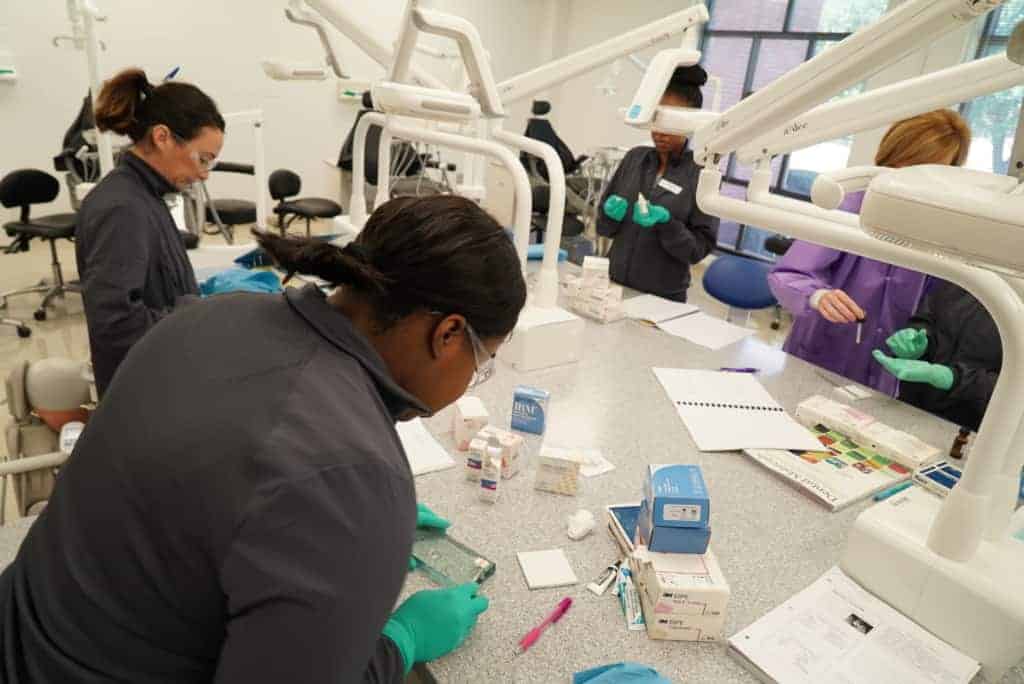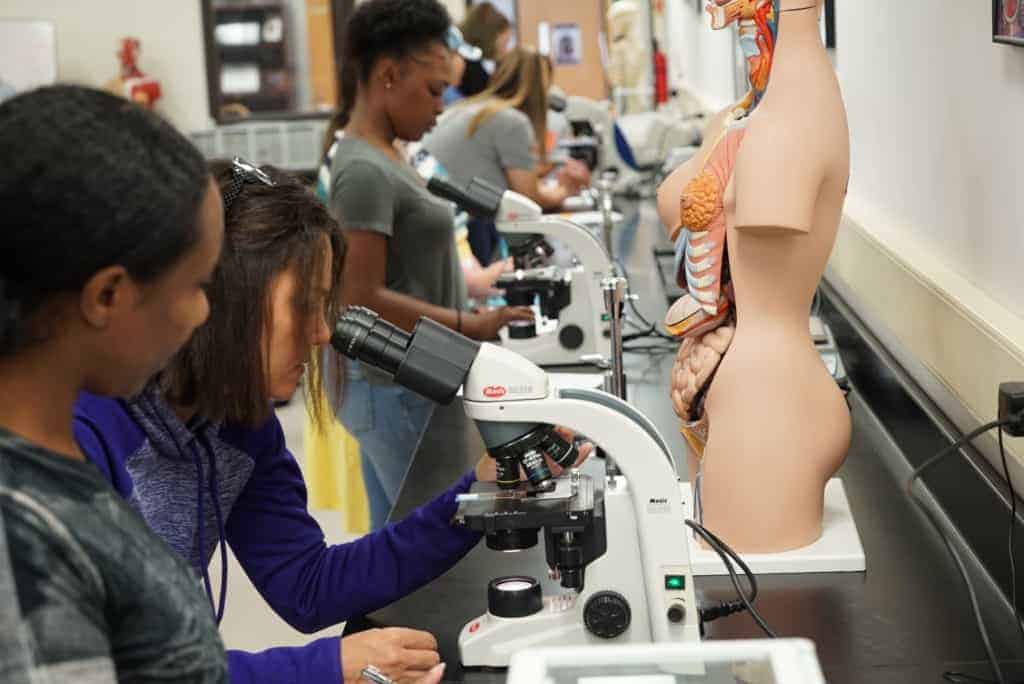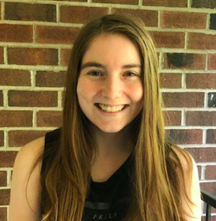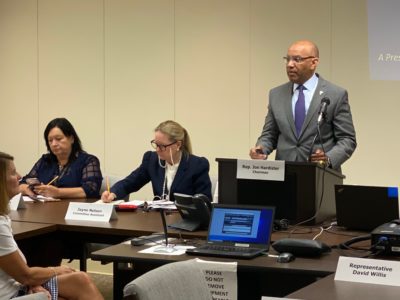
|
|
Disclaimer: This student paper was prepared in 2021 in partial completion of the requirements for Public Policy 804, a course in the Master of Public Policy Program at Duke University’s Sanford School of Public Policy. The research, analysis, and policy alternatives contained in this paper are the work of the student team that authored the document. They do not represent the official or unofficial views of the Sanford School of Public Policy or of Duke University. Without the specific permission of its authors, this paper may not be used or cited for any purpose other than to inform the client organization about the subject matter. For a PDF of the full report, including appendices, click here.
Contents
- Executive summary
- Why does North Carolina need a statewide community college promise program?
- What design practices should a statewide program include?
- Effective program design: What the research tells us
- Lessons from existing statewide programs
- Lessons from existing NCCCS promise programs
- Conclusion
Executive summary
North Carolina can make meaningful progress toward increasing statewide postsecondary educational attainment by expanding access to community college through a statewide community college promise program.
Promise programs are programs that increase access and affordability of postsecondary education through place-based scholarships, meaning eligibility is tied to residency in a defined territory. Exact definitions differ as cities and states have created unique programs for their needs, but several sources agree that place-based eligibility and common goals—increasing access through covering most costs, contributing to community and economic development, and building “a college-going culture”—make this distinct from other types of scholarships.
Promise programs have demonstrably increased postsecondary attainment in places where they have been implemented.1
North Carolina can learn from other states and 19 North Carolina Community College System (NCCCS) schools with promise programs to identify best design practices for a statewide community college promise program that would increase postsecondary attainment, maximize access and equity, and be cost-effective.
The degree to which a promise program addresses the three key values of access, equity, and cost-effectiveness varies with program design. The main design elements of a promise program are:
- Funding structure: How the scholarship is funded.
- Eligibility requirements: The criteria students must meet to qualify for the program.
- Persistence requirements: The criteria for maintaining scholarship eligibility once enrolled.
To identify best practices for promise program design, a team of graduate students at Duke University’s Sanford School of Public Policy reviewed existing research, conducted case studies, interviewed administrators from NCCCS schools with promise programs, and analyzed postsecondary education data.
Through a mixed methods research approach, the team found that North Carolina could incorporate the following best practices in a statewide community college promise program to increase attainment and maximize access, equity, and cost-effectiveness:
- Adopt a middle-dollar funding scheme for students’ tuition, fees, and supply costs, with available funds for students’ additional expenses combined with a Free Application for Federal Student Aid (FAFSA) requirement.
- Avoid eligibility requirements, particularly merit-based criteria.
- Incorporate proven persistence requirements of an annual credit and cumulative GPA minimum, paired with mandatory support services for students struggling with college academic requirements.
A first-dollar scheme can improve access by fully funding every student and a last-dollar scheme can maximize direct cost-effectiveness by only using promise program funding to fill in gaps left by federal and other aid.
However, a middle-dollar scheme balances access, equity, and cost-effectiveness by leveraging all available resources and funding critical additional expenses, like rent, for students with financial difficulties.
Requiring promise program applicants to submit the FAFSA, with completion support offered by community colleges, bolsters cost-effectiveness by ensuring that students will apply for external aid. A middle-dollar promise program, covering both tuition and non-tuition costs, would be a worthwhile investment for North Carolina.2
NCCCS promise program administrators have passionately underscored the barrier posed by non-tuition costs, like books, which could be mitigated by a middle-dollar funding scheme.3 Oregon uses a middle-dollar funding scheme for their statewide promise program, which has been associated with increased community college enrollment and a decreased racial/ethnic enrollment gap.4
Eligibility requirements restrict the pool of applicants and potential students a promise program can cover, negatively impacting access and, potentially, equity. Research indicates that promise programs without merit eligibility restrictions tend to improve postsecondary education access.5
Two NCCCS promise program administrators noted that merit requirements like Career and College Promise participation advantage students who are already poised for postsecondary success. However, students who are less equipped for postsecondary success tend to be associated with a relatively lower socioeconomic status and are therefore the most likely to benefit from promise programs.6 Thus, merit-based eligibility requirements can limit access for students who promise programs should be reaching and who are critical to increasing the level of postsecondary attainment in the state.
Research shows that merit persistence requirements, like GPA thresholds, increase the probability of degree completion.7 Requiring an annual, as opposed to per-semester, credit minimum allows students to balance course schedules with other responsibilities. Using a cumulative minimum GPA for graduation supports attainment while giving students flexibility if they experience challenging circumstances during a semester. Finally, research also shows that participation in support services, like academic counseling, can facilitate program completion.8
Why does North Carolina need a statewide community college promise program?
Policy question and key criteria
Promise programs contribute to community and economic development by increasing access and affordability of postsecondary education through scholarships tied to residency in a defined territory.9 Given growing interest in promise programs, this report investigates the following research question:
What best design practices would a North Carolina-wide community college promise program need to incorporate to increase postsecondary attainment, maximize access and equity, and be cost-effective?
To answer this question, the team reviewed existing research on promise programs, conducted case studies on three existing statewide promise programs, interviewed administrators from four North Carolina Community College System (NCCCS) schools with local promise programs, and analyzed postsecondary education data. Best practices were analyzed against three key values: access, equity, and cost-effectiveness. See Appendix A for more details on the research methodology.
Access is defined in this project as the relative ease with which potential students can enter the community college system. Maximizing access means ensuring that the relative cost of attendance is affordable (see Appendix B for a definition of “affordable” and other key terms), expanding eligibility for scholarships, and minimizing administrative hurdles in higher education.
Equity is defined here primarily in terms of race and socioeconomic status. The Center for Racial Equity in Education defines racial equity as “a state in which educational access and outcomes are independent of students’ social racial/ethnic backgrounds.”10
Socioeconomic equity is defined as a state in which educational access, opportunities, and outcomes are independent of the socioeconomic status of students. Maximizing equity means improving educational outcomes for students of all racial/ethnic and socioeconomic backgrounds.
Cost-effectiveness is defined as the degree to which the promise program is successful in achieving its goal in relation to its cost.11 This definition considers both direct and indirect savings and expenses from the program. Maximizing cost-effectiveness requires a clear goal and finding the least costly option to achieve it.

The need for a statewide community college promise program
North Carolina’s “2 Million by 2030″ goal aims for two million individuals ages 25 to 44 to hold postsecondary credentials by 2030; currently, only 1.3 million residents in this age bracket hold these credentials.12 This goal, set in 2019, stemmed from a growing need for high-skilled labor, as reports showed North Carolina employers struggling to fill positions due to a lack of trained applicants.13 Overall, 52.1% of residents ages 25 to 64 hold postsecondary qualifications, a figure in line with the national average of 51.9%.14
Education affordability is likely the biggest barrier to attainment in the state. Respondents to a 2018 EdNC and myFutureNC survey were asked which factors affected their decisions about when to end their formal schooling, and the most common response was “too expensive to continue.”15
The affordability gap means students are acquiring more debt to offset their inability to pay for their studies, which raises problems in terms of access, equity, and cost-effectiveness for the state. In North Carolina, state loan default rates are higher than the US average.16
Promise programs have been championed as a way for policymakers to address education affordability issues. President Joe Biden has expressed support of a free community college plan.17 Although definitions vary, most college promise programs across the country are “last-dollar,” meaning students must complete the Free Application for Federal Student Aid (FAFSA) and use any federal aid money on tuition expenses.
Under this funding scheme, any gap between federal and other aid and tuition costs are paid by the program. A few statewide promise programs are “first-dollar,” in which funding is not contingent on other aid. Most first-dollar programs fully cover tuition, allowing students who receive other aid to apply that aid towards other expenses. These programs generally have a higher cost per student than last-dollar programs. Lastly, there are “middle-dollar” programs, which provide last-dollar coverage plus a guaranteed scholarship amount.18
There are more than 365 college promise programs operating in at least 47 states.19 According to our promise program definition, 30 states and DC provide statewide promise programs targeted at two-year colleges or both two- and four-year colleges.20 In North Carolina, a few statewide programs exist—such as the Career & College Promise (CCP), Carolina Covenant, and NC Promise—yet none fully fund community college students.21
As of November 2020, 19 community colleges in North Carolina offered local promise programs. These scholarships are generally limited to residents of the county or counties served by the college, have minimum GPA requirements, only cover up to four semesters, and require entering community college the year after high school graduation. Some of these programs require students to have participated in the statewide CCP.22
5 reasons the NCCCS is crucial to achieving North Carolina’s 2 million by 2030 goal:
1. NCCCS colleges provide trained workers to the labor market in shorter timeframes than four-year institutions.
2. There is an NCCCS college within a 30-minute drive of nearly every North Carolina resident.
3. The NCCCS offers multiple options for part-time students, many of whom are also working.
4. A community college education can encourage many students to advance to a bachelor’s degree.
5. The NCCCS is more affordable than most N.C. public four-year universities.

What design practices should a statewide program include?
Promise programs are effective tools for increasing educational attainment. However, the degree to which a program increases attainment and how effectively it maximizes access and equity while being cost-effective varies with program design. The main design elements of a promise program are its funding structure, eligibility requirements, and persistence requirements.
For an overview of the criteria within each of these design elements, see Appendix C. Below, for each of the funding, eligibility, and persistence criteria, the team identifies best practices that North Carolina should consider if it were to implement a statewide community college promise program.
Funding structure
Use a middle-dollar funding scheme. In addition to last-dollar coverage, which would ideally apply to students’ tuition, fees, and supply costs, this would include a set amount each year that can be disbursed for additional expenses (e.g., rent) through a need-based application process.
Last-dollar programs can introduce considerable access and equity concerns in comparison to the other funding schemes, so it would be ideal for a statewide promise program to have either a first-dollar or middle-dollar funding scheme. If the North Carolina budget does not have enough revenue to finance additional expenses for all students, the program should offer tuition, fee, and supply coverage to all eligible students and prioritize additional aid for low‑ and middle-income students. In this sense, a middle-dollar program may be more cost-effective than a first-dollar program because the college can allocate funds based on the specific circumstances of every student.
Require all promise program applicants to complete the FAFSA. The FAFSA is a necessary step for middle- and last-dollar funding models because it requires students to apply for federal aid. To ensure that this requirement does not become a barrier, which would negatively impact access, equity, and attainment, community colleges should provide optional support to students as they complete the FAFSA (see “Support Services” in Persistence Requirements).
Eligibility requirements
Preferably, the promise program should not have an age restriction. If needed, define age eligibility to include those who graduated high school in the last five years, and implement a separate scholarship program for older students, like the Tennessee Reconnect program.
If North Carolina needs to limit age eligibility for direct cost-effectiveness, the program should not be restricted to those who have just graduated, because this would hinder access and equity. Further, estimates show that even if the high school graduation rate was 100% and these students enrolled directly in college, the state would likely not achieve 60% attainment by 2025.23
Do not use a financial need threshold for eligibility. Though there may be some equity concerns if a program is not restricting its eligibility to lower-income students, not having a financial need cap would maximize access and attainment.
Promise program eligibility should not be limited to specific degree programs. Research was inconclusive about the effects of limiting eligibility to specific degree programs, but general findings suggest that any additional eligibility restrictions would limit postsecondary access and attainment and have uncertain effects on equity and cost-effectiveness.
Avoid merit-based requirements for eligibility. To maximize access, equity, and attainment, it is advisable to forego any merit eligibility requirements in favor of merit requirements for persistence (see “Merit” in Persistence Requirements).
Persistence requirements
Require an annual credit minimum, equivalent to the credit hours of two full-time semesters (i.e., allow part-time students). Consider leaves of absence on a case-by-case basis. Mandating full-time, continuous enrollment in the Fall and Spring semesters is an access and equity issue for those who have specific academic needs or non-academic obligations. An annual credit minimum allows students to spread coursework across a full calendar year, not limited to two semesters, providing flexibility if students cannot take a full course load in a semester.
Provide FAFSA and college application support services (e.g., FAFSA assistance events) to prospective students. Non-mandatory support services would increase access, equity, and attainment by providing the assistance students need to attend and complete college.
Mandate support services (e.g., counseling) for enrolled students who are not meeting other persistence requirements. Research has shown that mandatory support services can help students remain in college.24
Do not require community service for promise program participation. There is limited research on the effect of community service requirements on promise program attainment, access, equity, or cost-effectiveness. In the absence of an established positive influence on these outcomes, such a requirement is a potential barrier to participation.
Require a cumulative GPA of 2.0 over the course of study. This requirement uses the standard minimum GPA for maintaining federal aid to ensure that students obtain the academic knowledge needed to graduate. A cumulative GPA instead of a 2.0 GPA for each semester increases access, equity, and attainment by offering flexibility if students performed poorly in some semesters.
Effective program design: What the research tells us
Though research on promise programs is relatively new, various think tanks, nonprofits, and academics have identified some best practices for program design.25
Overall, promise programs are effective in increasing educational attainment and promoting equity. Although estimations vary, studies have found some promise programs increased the attainment of any postsecondary credential by as much as 10 percentage points.26 Additionally, researchers have found that community college promise programs increase enrollment across racial/ethnic groups.27
A variety of program designs increase postsecondary credential attainment, but those with limited and simple requirements tend to be more effective in increasing access and reducing administrative costs.28 Also, there is evidence that promise programs in which many students are not confident that they will be eligible for the scholarship have smaller impacts on enrollment than programs that provide more certainty.29
Funding structure
First-dollar funding schemes lead to higher enrollment rates and increase equity by removing socioeconomic barriers.30 Though the investment for first-dollar programs is higher, the returns on investment may be budget neutral or net positive when considering potential savings and increased tax revenues in the future.31
Estimations developed for the U.S. House of Representatives’ Education and Labor Committee in 2019 found that for every $1 a state invests in higher education, it gets up to $4.50 in return.32 In North Carolina, 2013-2014 estimations suggest that every $1 invested in the NCCCS had an approximate return of $4.10 in benefits.33 Furthermore, research shows that helping low-income individuals attend college is key for poverty reduction in a community, and education can have beneficial social effects on arrest and teen birth rates.34
Last-dollar programs require a lower investment, but they generate mixed effects in terms of access and create equity concerns.35 Given a fixed budget, last-dollar programs can increase access by serving more people because they distribute less money per student. However, they also have a negative effect on access due to more administrative hurdles (such as FAFSA completion) and provide no financial aid for non-tuition-and-fee costs, which make the overall cost of school prohibitive for many students.36 Since federal need-based aid is applied first to pay for tuition, these programs provide fewer or no non-tuition funds to students with the most need, as their direct academic costs are largely or fully covered by federal aid.37
Experimental evidence suggests that offering students aid to cover housing, food, and other living expenses increases the probability of attainment.38 Homelessness and food insecurity are common among community college students in the US, so providing additional financial support for low-income students is an important consideration in a funding scheme decision.39 Although they identify as last-dollar, two statewide promise programs—Hawaii and Oregon—cover additional expenses through some middle-dollar coverage.40
Eligibility requirements
Regarding age requirements, research finds that only a few states will be able to reach a postsecondary education attainment goal of 60% of the population by 2025—in line with the national trend on educational goals—without students who are not recent high school graduates also entering higher education.41 An age requirement is a cutoff that substantially reduces direct costs and provides resources to people generally closer to the high school experience, who are the most likely to complete college.42
However, many students are not able to enroll in college immediately after high school. Providing older prospective students with options to obtain postsecondary education in a separate program, like Tennessee is doing with Tennessee Reconnect, might be an effective path to promote attainment, access, and equity by tailoring support services to older adults. In fact, preliminary research results indicate that Tennessee Reconnect reversed the downward trend in adult college attendance in Tennessee.43
Research finds that financial need caps are associated with lower enrollment across demographic groups, with the exception of Black males, relative to programs without such caps.44 Studies also show that FAFSA completion is a significant barrier to postsecondary attainment for low-income students.45 For a financial need requirement to effectively maximize access and equity, a promise program should provide FAFSA completion support. Studies indicate that providing such support effectively encourages students to apply for aid.46
There is very limited research on the effect of degree restrictions on promise programs. These restrictions would limit access and have mixed effects on equity depending on the subject areas favored by the restriction. Because this requirement could influence prospective community college students to study a specific degree, the restriction might be better pursued by individual community college programs or grants that can tailor degree-specificity to local workforce needs.
The literature generally indicates that programs without merit eligibility restrictions tend to improve both postsecondary education access and attainment.47 Research is mixed on whether programs with merit requirements increase postsecondary enrollment, since relatively high-achieving students were already very likely to participate in higher education.48 Evidence is also inconclusive about whether merit requirements enhance academic performance in high schools, which is reportedly one of the intended outcomes of programs with these criteria.49
Students who are less equipped for postsecondary success tend to be associated with a relatively lower socioeconomic status and are consequently the most likely to benefit from promise programs.50 Introducing a merit condition can therefore lead to an ineffective allocation of resources in the community, in which higher-performing students already eligible for other scholarships are the only ones eligible for the promise program.
Persistence requirements
Requiring a minimum course load equal to full-time status has a negative effect on access and equity in comparison to programs without that restriction. Many programs have a full-time requirement because research indicates full-time students are more likely to graduate.51
However, the literature suggests requiring full-time enrollment acts as a barrier for access to the program.52 Full-time status might not be possible for many students, especially low-income students, who may need to work to fund their education.53 This need to work for lower-income students is likely heightened when the program provides only tuition-and-fee financial aid.
Research shows that financial aid for postsecondary studies works more effectively when it is paired with well-designed student support services.54 Pre-enrollment support services, like FAFSA assistance, help increase access and equity.55 Post-enrollment support services, like academic counseling sessions, can improve student persistence in college and potentially increase graduation rates.56
One study finds that the proportion of North Carolina high school students with high enough test scores to qualify as “college- and career-ready” is only around 50%.57 Students who are not “college- and career-ready” might significantly benefit from partaking in mandatory support services, like counseling, if they perform below a merit-based persistence requirement.
Few studies have been conducted on the effect of a community service requirement on promise program access, equity, and cost-effectiveness. A study on the effect of community service on academic outcomes exposed mixed results.58 It is reasonable to think that, if a program has a community service requirement, the number of hours required must be limited since a high number of hours could be detrimental to attainment.
Research shows that a merit persistence requirement, such as a minimum GPA, increases the probability of degree completion.59 Merit persistence requirements will not decrease access and equity so long as they are in line with the college’s cumulative GPA requirement for graduation eligibility. In fact, these requirements can allow program officials to easily identify when a student’s low performance might hinder degree completion and target that student for support services.

Lessons from existing statewide programs
Although the national literature provides generalized findings on best practices for promise program design, it is useful to see how these practices have been implemented in existing programs. The research team examined three states with programs that have encouraging results in terms of access, equity, and cost-effectiveness: Tennessee, Delaware, and Oregon.
Case study: Tennessee Promise
Tennessee Promise has become one of the most prominent last-dollar community college promise programs in the nation since its inception in 2014. Tennessee Promise is funded through interest generated on a $361 million endowment fund.60 Students can use the Tennessee Promise to cover mandatory tuition and fees.61 The Program has been so successful that the state created a complimentary program for adult students, Tennessee Reconnect, in 2017.
Fast facts:
– Established in 2014
– Last-dollar promise program
– 42.7% of Tennessee residents ages 25-64 hold a postsecondary credential
– 83% statewide FAFSA completion rate (2020)
Available data paint a favorable picture of Tennessee Promise’s impacts on access and attainment. Analysis shows that the program has led to a spike in community college enrollment across the state.62 Nearly half (46%) of the Tennessee Promise’s first cohort of students now hold a postsecondary credential, suggesting that the program has positive effects on attainment.63 Approximately 8% of all Tennessee Promise participants have transferred to four-year institutions to continue their education, a trend that Tennessee Promise’s annual reports indicate is accelerating over time.64
Eligibility requirements:
– Online application
– Complete the FAFSA
– 8 hours of community service
– Attend meeting
Tennessee Promise has also been quite successful at bolstering equity. Annual reports show that community college enrollment increased across genders and racial/ethnic groups in Tennessee, though significantly more female applicants receive Promise funding than male applicants.65 Notably, Hispanic student enrollment has been steadily improving, with the percentage of Hispanic students growing from 3.5% to 7.1% from the program’s first cohort (2015-2016) to the most recent cohort (2020-2021).66
Persistence requirements:
– 8 hours community service per semester
– Maintain 2.0 GPA
– Maintain satisfactory academic progress
– Renew FAFSA annually
In Spring 2020, the average Tennessee Promise scholarship amount for students receiving funding was $1,094.67 The restriction of program funds to tuition and fee costs has allowed the program to serve a large number of students with a small amount of aid. As a result, the Tennessee Promise has been able to enroll over 108,000 students in Tennessee postsecondary institutions since 2015.68
Case study: Delaware SEED
Student Excellence Equals Degree (SEED) is Delaware’s largest postsecondary aid program, with an annual budget of $6 million. SEED recipients can use their funding to cover tuition costs.69
Some news outlets have reported that SEED has improved postsecondary access, but exact figures are difficult to find due to a lack of publicly available data.70 Compared to non-recipients, SEED recipients have displayed higher retention rates and degree completion rates, which are both positive indicators for attainment.71
Fast facts:
– Established in 2005
– Last-dollar promise program
– 42.4% of Delaware residents ages 25-64 hold a postsecondary credential
– 68% statewide FAFSA completion rate (2019)
SEED’s application requirements have raised equity concerns about the program. It is the only statewide promise program to deny any applicant convicted of a felony.72 This restriction was designed to deter teenagers from committing serious crimes, but it excludes young people with justice system involvement, for whom a postsecondary degree could be crucial to building a better future and discouraging recidivism.73 Furthermore, SEED requires a minimum high school and college GPA of 2.5, a barrier for students who are less successful academically than their peers.74 Given that both youth felony convictions and inadequate public education disproportionately impact vulnerable sectors of the population, these requirements might have negative implications for access and equity.75
Eligibility requirements:
– Complete the FAFSA (or equivalent for DACA students)
– No felony convictions
– 2.5 high school GPA
However, SEED employs some features that have made it more accessible to certain demographic groups. SEED is designed to be need-blind, so students from any socioeconomic background are eligible to receive funding.76 Recipients have publicly praised this choice, saying it helps cover many middle-class students who are ineligible for federal grants, without requiring above average academic performance.77 Additionally, SEED is one of only five statewide promise programs that accepts Deferred Action for Childhood Arrivals (DACA) recipients.78
Persistence requirements:
– Minimum 24 credits per academic year
– Continuous fall/spring enrollment
– Maintain 2.5 cumulative GPA
– Renew FAFSA annually
SEED has met the tuition need of all eligible students since 2006 without ever exceeding an annual budget of $6 million.79 Much of SEED’s financial success is due to additional investments from Delaware Tech, which implemented its own programming and additional funding to help most of its SEED recipients successfully graduate without debt.80
Case study: Oregon Promise
Oregon Promise is known as the country’s first middle-dollar statewide promise program.81
Fast facts:
– Established 2015
– Middle-dollar promise program
– 47.9% of Oregon residents ages 25-64 hold a postsecondary credential
– 52% statewide FAFSA completion rate (2020)
A statewide report found that Oregon Promise has increased community college access, with more Oregon high school students choosing to enroll in community college since the program’s launch in 2016.82 Early years of enrollment data across Oregon’s postsecondary institutions demonstrated that the rise in community college enrollment was accompanied by a slight decline in enrollment at state universities. This is evidence of a “downshift in enrollment” that many scholars have speculated might be a possible consequence of community college-specific promise programs.83 Postsecondary enrollment overall saw a slight net increase, yet it is too early to determine if increased access has translated into a net increase in postsecondary attainment.84
Eligibility requirements:
– Online application
– Complete the FAFSA/ORSAA
– 2.5 high school GPA
– Meet annual EFC limit
Although 77% of Oregon Promise funds go to students not receiving any Pell Grant funding, the program has still produced meaningful results for socioeconomic equity.85 Pell Grant recipients are more likely to also be Oregon Promise students, highlighting the utility of this program design to meet additional financial need for low-income students.86
In favorable findings for racial equity, Oregon Promise has reduced the racial/ethnic gap in statewide postsecondary enrollment by nearly 10 percentage points and accepts DACA recipients, improving access for a vulnerable group.87 There have been concerns, though, about reaching more first-generation college students, who are less likely to be Oregon Promise recipients on average and more likely, nationally, to be Black or Hispanic.88
Persistence requirements:
– Maximum 90 credits attempted
– Maintain satisfactory academic progress
– Maintain half-time continuous enrollment
– Renew FAFSA/ORSAA annually
Oregon has managed its program with an annual budget of $40 million, about $8 million less than experts say is needed to cover all eligible students.89 The insufficient funding has effectively made Oregon Promise a “first come, first serve” system in which many eligible students never receive funding.90 This problem has only been exacerbated by the COVID-19 pandemic: Oregon cut the program’s budget by $3.6 million in August 2020 to redistribute to other causes—at the cost of revoking Oregon Promise funding to more than 1,000 recipients.91

Lessons from existing NCCCS promise programs
Information from NCCCS colleges already implementing promise programs provided local context to this research. The data in this section of the report were obtained from seven NCCCS colleges: three were interviewed, three provided data, and one was both interviewed and provided data. Although the qualitative and quantitative data from these colleges are not statistically representative of all 19 NCCCS schools with promise programs, they reinforce many conclusions found in the comparative research. See Appendix D for the interview questions, Appendix E for the list of requested data, and Appendix F additional quantitative data analysis findings.
Funding structure
All seven of the NCCCS promise program schools that were interviewed and/or provided data classify their programs as having last-dollar funding schemes. Three NCCCS colleges provided data on their average promise program scholarship amounts, which ranged from about $200 to $2,000 per year. As last-dollar programs, the promise scholarships alone do not cover 100% of tuition for all students. Notably, one of the colleges reported that only 28% of their program participants receive promise scholarships, because the other 72% receive external aid that covers their tuition.92
One interviewee, who administers an endowment-funded promise program, wished that their college could offer stipends to meet non-tuition needs, which would replicate a middle-dollar funding scheme. An administrator of a county-funded program shared that, contingent on availability, their college offers students $1,000 per year for required course supplies and a one-time laptop stipend. The administrator highlighted that funding non-tuition costs is critical because a program could “waste a thousand dollars on tuition if [a student] will then have to drop out because they can’t buy the book…we want to make sure we are serving that student, and their success would be hindered if additional costs got in the way.”93
Every interviewee cited the FAFSA as a potential obstacle for applicants. Two administrators from programs with differing funding sources both thought their students could be deterred from completing the FAFSA if they assumed that they would not be eligible for need-based aid. Other administrators cited equity-related concerns with the FAFSA, especially for first-generation students: the form could be intimidating or unfamiliar, and parents might not have easy access to or be willing to share the needed information.
To partially address some equity concerns, two colleges reported that they have separate funding options for undocumented or DACA students, since their programs are only available for citizens. The four interviewed colleges all mitigate barriers to access, such as FAFSA completion, by offering direct support services to local high schools. To reach and assist applicants, one administrator from a small county-funded program spends one day per week at each high school within the county. Another administrator from a county-funded program serving a larger region relies heavily on high school support staff.
Eligibility requirements
All of the interviewees were passionate about their promise program’s role in honoring NCCCS’s “open door” ideal, but most acknowledged that barriers arose from at least one of their eligibility requirements. All the interviewed colleges require county residency, two require some level of CCP participation, and two have a minimum high school GPA. County-specific limitations are currently unavoidable but would be eliminated with a statewide program.
In terms of age, promise programs at interviewed colleges were designed for recent high school graduates, but none require enrolling the semester immediately after high school completion. One program allows enrollment within two years of high school completion. At another college, the interviewee expressed interest in expanding promise program access regardless of age. To balance cost concerns and access, the interviewee suggested opening eligibility from those who graduated high school in the last year to high school graduates from the past five years.
Only one of the 19 NCCCS colleges with promise programs includes financial need in their program eligibility. In fact, every interviewee felt that their program fills a critical gap for students ineligible for Pell Grants. One interviewee remarked:
“I don’t know that all these students would have come here without [the promise program] and then we would have missed that investment in the economic health of our students and our local community.”94
Data show full-time, first-time undergraduates are more likely to receive institutional grant aid at the NCCCS colleges with promise programs than at other NCCCS colleges. The 19 NCCCS schools with promise programs provided 22% of their full-time, first-time undergraduates with institutional grant aid, on average, compared to a 12% average for the other 39 NCCCS schools. The average amount of grant aid per student at promise program colleges was $1,374, slightly higher than the $1,175 per student average across the non-promise program colleges awarding grant aid.95
Given that billions of dollars in free Pell grants remain unclaimed each year, the generosity of a promise program could draw interest from Pell-eligible students who might not pursue college due to cost concerns.96 One interviewee estimated that around half of their college’s promise program participants received federal aid.
Across all NCCCS colleges with promise programs, the average share of undergraduates awarded Pell Grants was 38%, and the average amount of Pell Grant aid awarded per student was $5,220. These figures are slightly higher than the averages at non-promise colleges. This may indicate a positive correlation between the existence of promise programs and increased enrollment of Pell-eligible students at NCCCS colleges, but more research would be needed to confirm that relationship.97
A majority of NCCCS promise programs have merit-based eligibility components, with most requiring some CCP participation and many stipulating a minimum high school GPA. Most of the interviewees did not think that their merit-based standards hindered program access. One college, which required CCP but did not have a minimum GPA requirement, estimated that fewer than 10 out of over 200 students who expressed interest in their program were at risk for not meeting the eligibility requirement. Only one interviewed college did not limit eligibility through merit; the college believes that if CCP were required, students who their college wants to serve would be “left behind.”98
To ensure eligible students can access the promise programs, all the interviewed colleges offer pre-enrollment support services. Designated staff work with local high schools to promote the program and help with applications. Most of the colleges avoid strict deadlines and make grant offers for as long as possible—one interviewee, whose promise program had a minimum high school GPA but no CCP requirement, reported that they have accepted students as late as four days before the start of the semester. Through support services, administrators hope to foster a “college-going culture,” in which students believe that postsecondary education is within reach. One administrator, from a rural college near an urban center, felt their program was already increasing those feelings locally.
Persistence requirements
Persistence criteria were not discussed as frequently in interviews because the staff primarily work in program admissions, but retention is a priority for any college. The average retention rate across NCCCS colleges with promise programs is 62%, in line with the average retention rate across all NCCCS schools.99
One college reported that, of those who received scholarships in the 2020-2021 academic year, the majority were returning students. However, they did not specify whether the non-returning students graduated or dropped out of school or the promise program.100
Most NCCCS colleges have a merit persistence requirement of a minimum GPA for maintaining program funding. One college requires a cumulative 2.0 GPA but allows a lag period across semesters to give students time to bring grades back up if they struggle.
Concerning minimum course load, one college was unique in not having a full-time enrollment requirement, though students can only receive funds over the course of two years. Another interviewee expressed an interest in funding part-time students, who are not currently eligible for their program, but acknowledged that a credit hour or semester cap would likely be needed for financial sustainability.

Conclusion
North Carolina can make meaningful progress toward increasing postsecondary educational attainment by expanding access to community college through a statewide community college promise program. The state could incorporate the following best practices in a statewide community college promise program to increase attainment and maximize access, equity, and cost-effectiveness:
- Adopt a middle-dollar funding scheme for students’ tuition, fees, and supply costs, with available funds for students’ additional expenses, combined with a FAFSA requirement.
- Avoid eligibility requirements, particularly merit-based criteria.
- Incorporate proven persistence requirements of an annual credit and cumulative GPA minimum, paired with mandatory support services for students struggling with college academic requirements.
If there is interest in further research on this topic, conducting a survey or focus group study to assess the promise program participant experience would be recommended. For more detail on opportunities for additional research, see Appendix G.
Editor’s note: On May 24, 2021, Gov. Roy Cooper announced the Longleaf Commitment program for 2021 high school graduates from low- and middle-income families. The grant guarantees that eligible students receive $700 to $2,800 per year, for a total of two years if they attend one of the state’s 58 community colleges. He also announced the Longleaf Complete Grant program for college students “whose education has been interrupted during the pandemic.” Both programs apply to the 2021-22 and 2022-23 school years and are funded by North Carolina’s share of the Governor’s Emergency Education Relief (GEER) fund.









